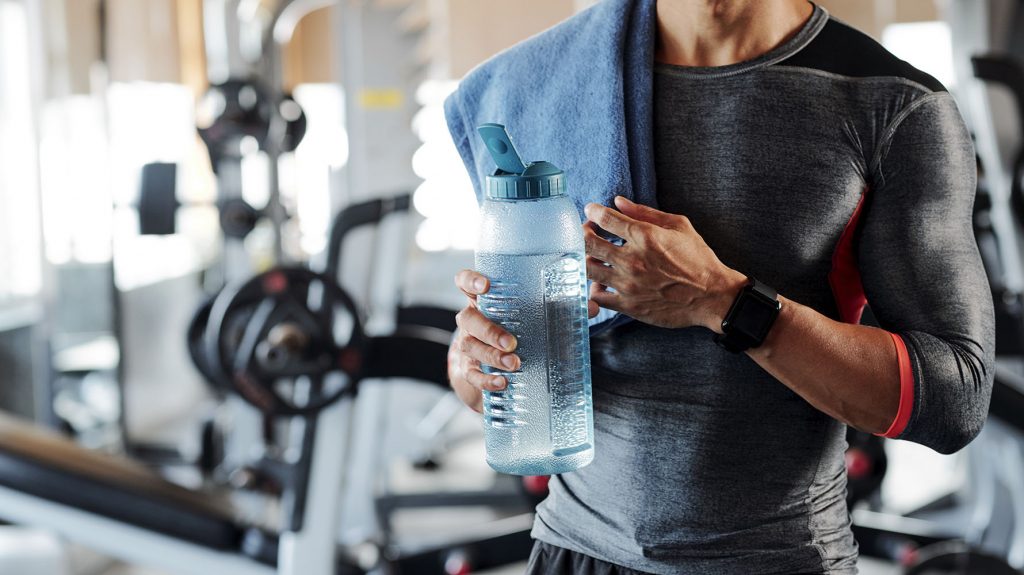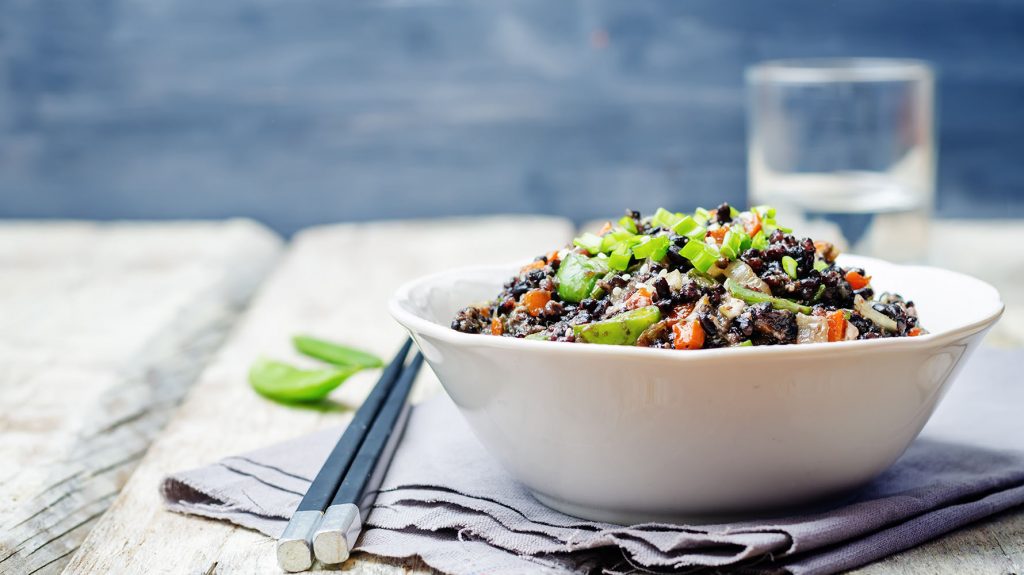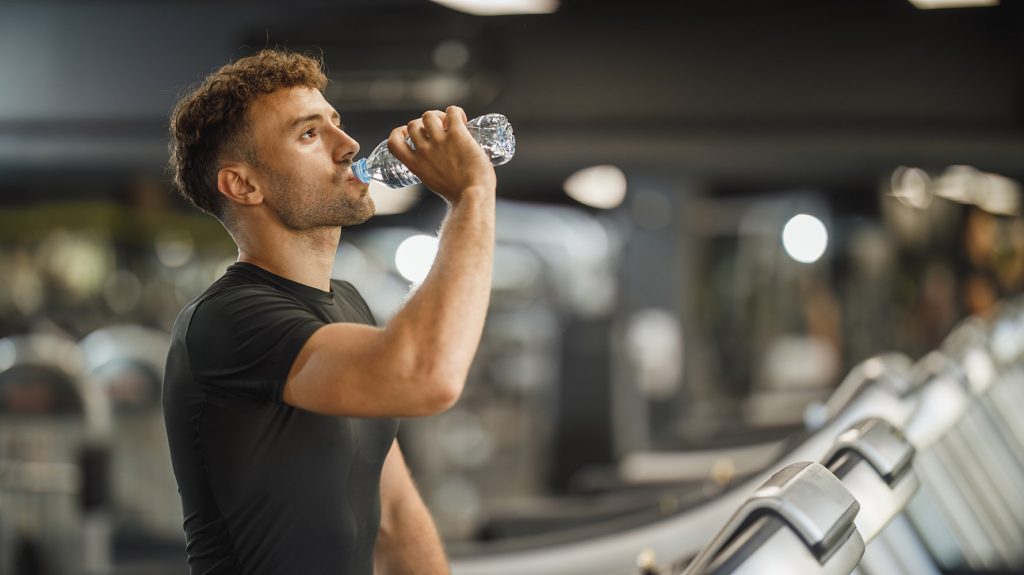How Much Water Should an Athlete Drink a Day: Diet for Athletes

The diet in the life of an athlete plays a significant role (it is important for both amateur athletes and professionals), because without a corresponding load of replenishment of energy reserves, vitamins, minerals, etc. You are unlikely to be able to achieve meaningful fitness development. Eating improperly or eating junk food, you run the risk of nullifying all the efforts, time and resources that you spend in the gym, working hard and improving your body. And this is just the tip of the iceberg, the consequences here can be much more serious, up to the development of ailments potentially dangerous to health and a drop in working capacity.
At the same time, it should be understood that drawing up a diet for sports is not as simple a process as it might seem. In this area, there are many nuances that must be taken into account – starting with the percentage distribution of proteins, carbohydrates and fats in food and ending with the time of intake of this very food. In addition, on certain days, your sports diet may change significantly, which must also be taken into account. So, during the period of ordinary training, he can be one, in preparation for a performance – another, and during recovery / rest – the third, etc.
In this material, we want to help, first of all, beginners to understand what it is worth starting from in order to compose the correct diet when playing sports, and what to strive for. However, this information may also be useful for experienced athletes who want to make adjustments to a long-existing, but seemingly sub-optimal or outdated diet. Please note that the data below is rather a collection of useful recommendations and advice than a direct guide to action, therefore, it is worth treating them only this way and nothing else. We are all different people, therefore the needs of our organisms are different, depending on physiology, place of residence, sport, environment, climatic conditions and many other indicators.

Healthy Diet for Athletes
Without further ado, let’s get down to business. So, first and foremost, you need to determine what should provide the correct diet, built for sports purposes. There are a few main points here:
- Firstly, he must take into account your energy needs, taking into account the sports load (energy expenditures during sports activities largely depend on age, gender, weight, discipline, climate and a number of other factors);
- Secondly, the sports nutrition regimen should be built with the expectation of a quick recovery after physical. loads, as well as to replenish missing nutrients, like minerals or vitamins;
- Thirdly, it must ensure the maintenance of the athlete’s optimal weight and body fat content;
- Fourthly, the diet of a person who is fond of sports at an amateur or professional level always takes into account the water and electrolyte balance.
Regarding the first point, which requires a correct healthy diet, it is important to clarify that, on average, the minimum energy requirement of the male body is 46 * Body weight (in kilograms) kcal, while for the female body the average indicators are 40 * Body weight (in kilograms). This value can vary significantly, and it depends not only on weight and gender, which is obvious, but also on other factors, in particular on the kind of sport in which you are engaged.
The following table, revealing the sports nutrition regimen, will show in more detail how voluminous in terms of energy value the diet of an athlete who is fond of a particular discipline should be:
- The diet for such a type as athletics (throwing a discus, javelin, sprinting, jumping) in men requires the energy value of the diet in 3700-4200 kcal, in women – 3200-3600;
- Running for long and cross distances for men is 5000-5500 kcal, for women it is more modest 3200-4700 kcal;
- Skiing short distances, as well as jumping and slalom for men – 4400-4700 kcal, for women – 3700-4000 kcal;
- The energy value, which should correspond to the correct diet of an athlete in skiing at long distances, for men – 4800-5000, for women – 4100-4250 kcal;
- Kettlebell lifting, wrestling and boxing for men – from 4200 to 6000 kcal, the same sports for women – about 4000 kcal;
- Gymnastics and fencing for women – 3000-3600 kcal, for men – 3600-4200 kcal;
- Men’s volleyball and basketball – 4200-4500 kcal, women’s – from 3600 to 3800, etc.
In general, in the studies of the Russian Academy of Medical Sciences (RAMS), the average daily energy expenditure was established, which should replenish the diet and diet, with increased sports activities: for men it is 3500-6500 kcal, for women – 3000-6000 kcal. This norm has its exceptions, in particular, for an athlete participating in marathon running and / or cycling, energy consumption can increase up to 7-8 thousand kcal. In addition, it should be borne in mind that if your main sports discipline is combined with some amateur athletic hobbies (for example, if you do weightlifting and play hockey in the evenings), then the energy value of the diet should again be increased (with short-term intense physical activity – by 500-800 kcal, with prolonged – by 800-1500 kcal).
It is also important to clarify that a sports diet, your diet, is recommended to be based on the following ratio of the main food components: carbohydrates – about 60-70%, fats – on average from 20 to 25% (animal fats should make up 80-85 percent of all fat in food, the rest is vegetable oils), and, of course, proteins – about 10-15%. Here are some more specific guidelines to help you plan a healthy diet for your sport:
- Eating during normal workouts equates to the main type of food and usually includes foods that provide the body with the necessary amount of protein and carbohydrates. Here, veal, beef, pork, rabbit, lean lamb and other products are recommended for consumption. It is reasonable to include fresh vegetables and fruits in the daily regimen / diet, due to which at least 15-20 percent of daily energy will be provided;
- In turn, the diet during intensive training sports and during the competition should be more intense. Here it is worth limiting the amount of fatty and smoked meat, fried foods, legumes, sauerkraut and a number of other specific products consumed;
- The sports diet of a person in conditions of long-term competitions (at a distance) also takes a unique turn. In this regimen, it is necessary to consume glucose and sugar in combination with other food structures in pure form. In addition, it is recommended to consume chocolate, especially those samples where sugar is replaced by glucose. All this will provide the athlete’s body with quickly and easily assimilated substances that do not overload the digestive system.
Now, discussing the diet of a person seriously involved in sports, we will tell you how and when it is better to consume food, and in what proportions. So, during training camps, it is advised to carry out at least four meals a day. In this case, the minimum recommended interval of fifteen to twenty minutes between the end of the workout and the consumption of food should be observed (preferably 30-40 minutes to fully restore the circulatory function after strenuous and intense physical activity). In addition, observing the diet in sports, you cannot start training on an empty stomach, however, you should not eat directly before starting classes (this is potentially harmful and can lead to a decrease in performance). Important: in any case, the time between meals should not exceed five hours, plus, on the day of the competition, it is not recommended to eat later than three hours before the performance.
If your training takes place in the first half of the day, then you should observe the diet, according to which 30-35 percent of the daily energy value of the diet falls on tomorrow, 35-40% – for lunch, about 5 percent – for an afternoon snack, and the last 25 -30 percent for dinner. In turn, when training in the afternoon, the athlete’s diet should be slightly modified: here 35-40 percent of the energy value of the diet falls on breakfast, about 30-35 percent – for lunch, the same five percent – for an afternoon snack, 25-30% – for dinner.
For reference: RAMS recommends to carry out a 5 meals a day with the inclusion of various restorative agents, both before and after an intense workout, with the energy value of each of their consumption not exceeding 10% of the daily diet. At the same time, the distribution of energy value between meals, according to experts, should be as follows – 25 percent for breakfast, 35 percent for lunch and 20 percent for dinner.
And one more thing: the correct human diet is far from the only thing that contributes to the improvement of athletic performance. You may be helped in this matter, or you may need some aids. In particular, to correct weight, you can buy fat burners, which have proven themselves well both among beginners and already experienced athletes, to improve strength and muscle gain – drugs of the AAS category. And, of course, do not forget about the benefits that special sports nutrition brings (we practically did not talk about it in this material, since this topic is voluminous, requiring a separate, thorough examination).

How Much Water Should an Athlete Drink Daily?
To begin with, to introduce you to the course of the matter, we will give a little general information and theory useful for studying. So, the drinking regime is the established procedure for the consumption of liquids (juices, mineral water, ordinary drinking water, etc.), the specificity of which depends on a person’s age, gender, type of activity and living conditions / environment (food, climate, etc. ). The correct, that is, rational drinking regime of a person ensures the maintenance of the body’s water-salt metabolism necessary for vigorous activity, and this is only one of the aspects of his duties, aspects of which in fact are much more.
It is known that normally the amount of water consumed and produced in our body almost completely corresponds to its allocated volume. On average, a healthy and adult person needs about 35-40 ml per 1 kg of body weight per day, approximately such norms should be replenished by a drinking regimen in an ordinary setting, so that the body works like a clock. For reference: a child under one year old has higher water / fluid requirements – about 165 ml per 1 kg of body weight, this should be taken into account.
Why is adherence to the drinking regime of great importance even for those who are not fond of sports? There are a lot of reasons, but we will list only a few of them. First, excessive fluid intake can be addictive. Secondly, this may be a consequence of violations of osmoregulation, renal excretory function and other abnormalities. Thirdly, if the water-drinking regime is incorrect and too much water enters the body, this usually causes an increase in blood volume, a decrease in the number of its formed elements, contributes to the development of digestive disorders, deterioration of the cardiovascular system, the appearance of seizures and other rather serious pathological conditions …
On the other hand, if the organization of the drinking regimen was carried out, so to speak, with a lack of norms, that is, if you drink too little, this also does not bode well for your health and well-being. In such situations, there is often a decrease in performance, endurance, strength indicators, abnormalities in the work of the cardiovascular system, central nervous system, impaired coordination, and so on. Fact – with water losses of more than 20% of the total body weight, death occurs (although it is practically impossible to achieve such losses by chance, 20% of the “outflow” in most cases develops due to diseases and for other reasons beyond the control of a person).
The water-drinking regime is of particular importance in summer, in heat and, in general, in hot climates. In such an environment, there is usually increased dehydration and demineralization of the body, which is fraught with consequences. In particular, at an air temperature of 32 degrees or more, the secretion of sweat glands sharply increases and almost all heat transfer is carried out due to evaporations alone. In normal temperate climates, water loss due to perspiration is approximately 0.5-0.6 liters per day. In conditions of high temperatures, especially if hard work (training, etc.) is performed, this figure can increase to 6-9 liters.
Therefore, in hot weather, it is advisable for a person to have an enhanced drinking regime, which is capable of eliminating a negative water balance (loss of body fluids exceeding replenishment). What is it about? The fact that in such conditions it is necessary to consume more water than usual, but this must be done correctly – as thirst arises, you need to drink no more than 200-300 ml at a time, preventing the occurrence of unpleasant sensations associated with an overflow of the stomach.
Note that increased sweating often leads to the loss of additional amounts of ions of copper, magnesium, sodium, calcium, zinc, chlorine, water-soluble vitamins (B1, PP, and so on), organic acids and other useful structures. If the evaporation of sweat does not exceed 4-5 liters, then the correct drinking regime of a person can fully compensate for the loss of sodium chloride. Therefore, use special salted water – 0.3-0.5% sodium chloride solution, should be used only with a decrease in body weight due to increased sweating over 5 kg per day.
What drinks can and should include a person’s drinking regime in the summer, in the heat? With prolonged heat exposure, black and green long tea with the addition of vitamins are effective, since when they are used, dry mouth disappears and the amount of liquid drunk decreases – up to 1.9 times compared to the usual consumption of water. Also useful here is green tea with the addition of a decoction of camel thorn (it can replenish vitamins and ions lost with sweat, help to improve the thermal state and normalize the work of the cardiovascular system). Your drinking regimen and diet may include various drinks, which, along with trace elements, also contain a complex of organic acids (ascorbic, citric, and so on), the need for them is explained by the fact that when overheating, the so-called acid appetite regularly occurs. It is also advisable in the heat to consume soft drinks that help reduce sweating and lower body temperature.
Now, when we are done with the basics, let’s talk about what the organization of an athlete’s water-drinking regime should be based on. First and foremost, you need to understand that, as in the case of nutrition, the drinking regimen with intense physical exertion, depending on the severity of these very loads, provides for special regulation, which varies both in the composition of drinks and the amount, and in the time of their intake. For example, you should avoid drinking too much fluids during competition and during your workouts, and quench your thirst at the end. There are many different nuances and subtleties that must be taken into account in order to draw up the correct drinking regimen and diet.
In fact, a normal water-salt balance is one of the main conditions for maintaining the physical performance of an athlete, for the correct functioning of the brain under increased stress and for the recovery of the body after injuries. As already mentioned, a negative water balance arising from the fact that the drinking regimen during sports was not organized correctly can cause a serious blow to sports performance. And this is just the tip of the iceberg, the consequences can be much more serious – up to an increase in the risk of injury, disruption of the cardiovascular system, central nervous system and other aspects.
Since thirst is an unreliable indicator of the body’s need for water, the American college of sports physicians who care about an athlete’s drinking regimen (otherwise they would not do this) have developed guidelines suggesting how it should be formulated. According to these recommendations, drinking water alone is likely to be sufficient to replenish fluid losses when exercising less than one hour. For loads lasting more than an hour to receive, various sports drinks are recommended, which include glucose, sodium and other substances useful in sports (this category includes isotonics and other liquids created today mainly for sports purposes).
Drinking regime for regular and prolonged exercise (according to the recommendations of the American College of Physicians):
- 500 ml 2 hours and immediately 30 minutes before exercise oximetholon-hu.click (in small and even portions);
- 250 ml 5-10 minutes before exercise;
- From 100 to 250 ml every 15-20 minutes during exercise;
- About 1000 ml for every kilogram lost during exercise, within 6 hours of completion (in small and even portions).
In general, the correct drinking regime and diet in sports should ensure the observance of water-salt metabolism and create favorable conditions for the vital activity of the body, taking into account the increased physical and psychological stress inherent in a particular sports discipline. If this topic is not taken seriously, then you can run into quite serious deviations that can affect physical fitness and sports results – digestive disorders, deterioration in working capacity (strength, endurance, etc.), deterioration in concentration, the risk of functional disorders in the work of the cardiovascular system etc.